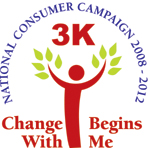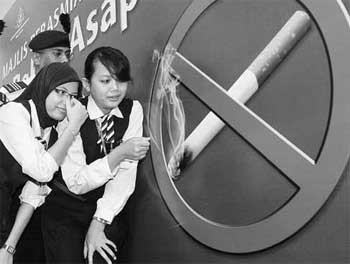| TOBACCO: Go light up somewhere else |
 |
 |
 |
| Written by 3K Admin |
| Tuesday, 07 July 2009 09:05 |
|
2009/07/07
SHS produced by burning tobacco products causes cancer, heart disease and many other serious diseases. There are 4,000 known chemicals in tobacco smoke, including nicotine (a poison which causes addiction), tar (contains cancer-causing agents) and carbon monoxide. Studies have found that there is no safe level of exposure to second-hand tobacco smoke. Neither ventilation nor filtration, even in combination, can reduce the exposure indoors to levels that are considered acceptable.Only 100 per cent smoke-free environments provide effective protection. This is in line with the Article 8 of the World Health Organisation's (WHO) Framework Convention on Tobacco Control (FCTC), which Malaysia ratified in September, 2005. As party to the FCTC, Malaysia is obligated to ensure that all public and work places are 100 per cent smoke-free. Hence, the requests for designated smoking areas inside any public buildings must not be entertained and should be seen as an effort to undermine the government's effort to protect Malaysians from the effects of smoking. Based on the WHO Report on the Global Tobacco Epidemic 2008 -- The MPOWER Package, at least 200,000 workers die every year due to exposure to second-hand smoke at workplaces. An estimated 700 million children, or almost half of the world's children, breathe air polluted by tobacco smoke, particularly at home. Second-hand smoke causes serious illnesses in children and worsens conditions such as asthma. The United States Environmental Protection Agency estimates that second-hand smoke is responsible for about 3,000 lung cancer deaths annually among non-smokers in the country. Exposure to SHS also imposes economic costs on individuals, businesses and society, in the form of direct and indirect medical costs and productivity losses. Based on the Third National Health Morbidity Survey 2006, the prevalence of adult smokers was 21.5 per cent, constituting about 2.7 million people. It is frightening to note that half of Malaysian adult males are established smokers. Another 2.7 million of our adult population were identified as passive smokers (that is, non-smokers who are exposed to someone else's cigarette smoke for at least 15 minutes each exposure for at least three days in the week). There were more adult female passive smokers (23.8 per cent) compared with males (18.7 per cent). It is alarming that more than 300,000 (26.8 per cent) adolescents (aged less than 18) are passive smokers. More girls (29 per cent) are exposed to SHS than boys (24.7 per cent). Given the large number of smokers and innocent people exposed to the negative effects of SHS, ensuring a smoke-free environment is the only way to protect all Malaysians from the lethal ill effects of tobacco smoke. Hence, the Malaysian Pharmaceutical Society fully supports the creation, expansion and enforcement of 100 per cent smoke-free environment, including at all workplaces. We urge the government to duly protect the people from second-hand tobacco smoke, which is akin to pulmonary rape of innocent victims on a constant basis. Source: http://www.nst.com.my/Current_News/NST/Tuesday/Letters/2600766/Article/index_html |
| Last Updated on Tuesday, 07 July 2009 09:10 |


